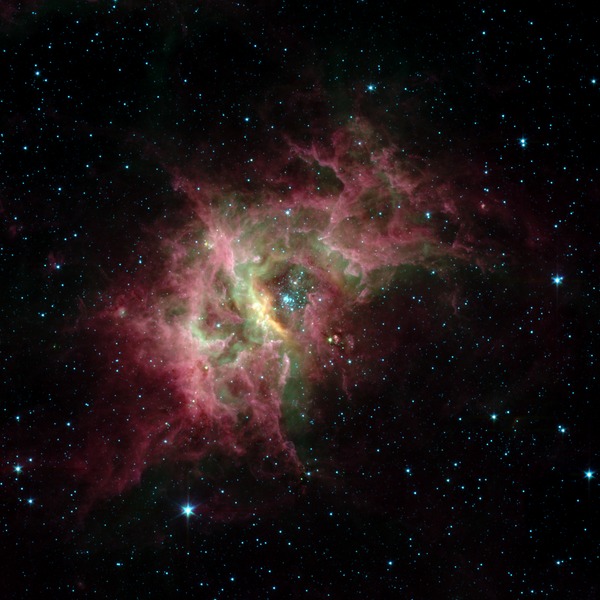File:Ssc2004-08a1.tif

Original file (1,520 × 1,520 pixels, file size: 2.93 MB, MIME type: image/tiff)
Captions
Captions
Summary
[edit]| DescriptionSsc2004-08a1.tif |
Star Formation in RCW 49 One of the most prolific birthing grounds in our Milky Way galaxy, a nebula called RCW 49, is exposed in superb detail for the first time in this new image from NASA's Spitzer Space Telescope. Located 13,700 light-years away in the southern constellation Centaurus, RCW 49 is a dark and dusty stellar nursery that houses more than 2,200 stars. Because many of the stars in RCW 49 are deeply embedded in plumes of dust, they cannot be seen at visible wavelengths. When viewed with Spitzer's infrared eyes, however, RCW 49 becomes transparent. Like cracking open a quartz rock to discover its jewels inside, the nebula's newborn stars have been dramatically exposed. This image taken by Spitzer's infrared array camera highlights the nebula's older stars (blue stars in center pocket), its gas filaments (green) and dusty tendrils (pink). Speckled throughout the murky clouds are more than 300 never-before-seen newborn stars. Astronomers are interested in further studying these newfound proto-stars because they offer a fresh look at star formation in our own galaxy. This image was taken on Dec. 23, 2003, and is composed of photographs obtained at four wavelengths: 3.6 microns (blue), 4.5 microns (green), 5.8 microns (orange) and 8 microns (red).
Name NGC 3247 • RCW 49 • Gum 29 Type Nebula > Type > Star Formation Nebula > Appearance > Emission > H II Region Distance 13,700 Light Years Color Mapping Band Wavelength Telescope Infrared 3.6 µm Spitzer IRAC Infrared 4.5 µm Spitzer IRAC Infrared 5.8 µm Spitzer IRAC Infrared 8.0 µm Spitzer IRAC About the Color Mapping Table Astrometrics Position (J2000) RA = 10h 23m 57.2s Dec = -57° 45' 9.0" Field of View 30.4 x 30.4 arcminutes Orientation North is 32.4° right of vertical Constellation Carina |
| Source |
http://www.spitzer.caltech.edu/images/1168-ssc2004-08a1-Star-Formation-in-RCW-49 http://www.spitzer.caltech.edu/uploaded_files/images/0009/1473/ssc2004-08a1.tif |
| Author |
Credit NASA/JPL-Caltech/E. Churchwell (University of Wisconsin) |
| Permission (Reusing this file) |
http://www.spitzer.caltech.edu/info/18-Image-Use-Policy |
Licensing
[edit]| Public domainPublic domainfalsefalse |
| This file is in the public domain in the United States because it was solely created by NASA. NASA copyright policy states that "NASA material is not protected by copyright unless noted". (See Template:PD-USGov, NASA copyright policy page or JPL Image Use Policy.) |  | |
 |
Warnings:
|
File history
Click on a date/time to view the file as it appeared at that time.
| Date/Time | Thumbnail | Dimensions | User | Comment | |
|---|---|---|---|---|---|
| current | 10:34, 29 November 2013 |  | 1,520 × 1,520 (2.93 MB) | Fabian RRRR (talk | contribs) | {{Information |Description='''Star Formation in RCW 49 One of the most prolific birthing grounds in our Milky Way galaxy, a nebula called RCW 49, is exposed in superb detail for the first time in this new image from NASA's Spitzer Space Telescope. Loc... |
You cannot overwrite this file.
File usage on Commons
The following page uses this file:
File usage on other wikis
The following other wikis use this file:
- Usage on az.wikipedia.org
- Usage on ce.wikipedia.org
- Usage on de.wikipedia.org
- Usage on diq.wikipedia.org
- Usage on eo.wikipedia.org
- Usage on lb.wikipedia.org
- Usage on mk.wikipedia.org
- Usage on nl.wikipedia.org
- Usage on ru.wikipedia.org
- Usage on sk.wikipedia.org
- Usage on tr.wikipedia.org
- Usage on tt.wikipedia.org
- Usage on uk.wikipedia.org
- Usage on www.wikidata.org
Metadata
This file contains additional information such as Exif metadata which may have been added by the digital camera, scanner, or software program used to create or digitize it. If the file has been modified from its original state, some details such as the timestamp may not fully reflect those of the original file. The timestamp is only as accurate as the clock in the camera, and it may be completely wrong.
| Image title | One of the most prolific birthing grounds in our Milky Way galaxy, a nebula called RCW 49, is exposed in superb detail for the first time in this new image from NASA's Spitzer Space Telescope. Located 13,700 light-years away in the southern constellation Centaurus, RCW 49 is a dark and dusty stellar nursery that houses more than 2,200 stars.
Because many of the stars in RCW 49 are deeply embedded in plumes of dust, they cannot be seen at visible wavelengths. When viewed with Spitzer's infrared eyes, however, RCW 49 becomes transparent. Like cracking open a quartz rock to discover its jewels inside, the nebula's newborn stars have been dramatically exposed. This image taken by Spitzer's infrared array camera highlights the nebula's older stars (blue stars in center pocket), its gas filaments (green) and dusty tendrils (pink). Speckled throughout the murky clouds are more than 300 never-before-seen newborn stars. Astronomers are interested in further studying these newfound proto-stars because they offer a fresh look at star formation in our own galaxy. This image was taken on Dec. 23, 2003, and is composed of photographs obtained at four wavelengths: 3.6 microns (blue), 4.5 microns (green), 5.8 microns (orange) and 8 microns (red). |
|---|---|
| Author | Spitzer Space Telescope |
| Copyright holder | http://www.spitzer.caltech.edu/Media/mediaimages/copyright.shtml |
| Width | 1,520 px |
| Height | 1,520 px |
| Bits per component |
|
| Compression scheme | LZW |
| Pixel composition | RGB |
| Orientation | Normal |
| Number of components | 3 |
| Number of rows per strip | 57 |
| Horizontal resolution | 72 dpi |
| Vertical resolution | 72 dpi |
| Data arrangement | chunky format |
| Software used | Adobe Photoshop CS3 Windows |
| File change date and time | 11:08, 22 October 2008 |
| Color space | Uncalibrated |
| warning | wrong data type 7 for "XMLPacket"; tag ignored. |